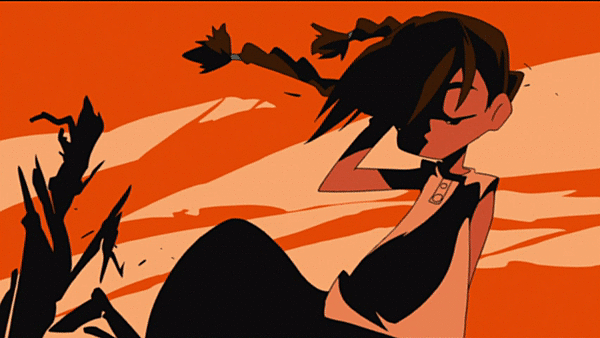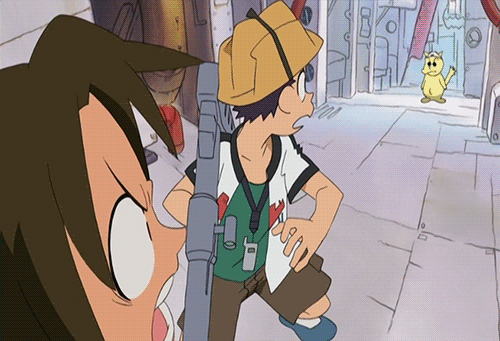

Ah, the Abenobashi Shopping Mall Arcade. I remember my initial run in with this series as an adolescent-child at a friend's house. Despite being only in elementary school, my friend managed to have a copy of this DVD in his possession. This was back when paying twenty dollars for a DVD containing only three or so episodes was the norm. But I digress, even at a young age, though my face was beet-red during all of Mune-Mune’s scenes, I still noted the elasticity of the characters, the warm vibe, and varied artstyle this show had. I was eager to continue watching this other-worldly show as soon as I got home, but alas I hadn’t the slightest clue of what the name of the show I just witnessed was. So for years, this anime lived rent free in my head until I stumbled upon it by accident some point after I’d already gotten my feet wet into the anime medium. So after finally watching, and then rewatching, this show that I’d always thought about for the last ten years, did it live up to the fond memory I had of it as a child, or did it fail to reach my expectations?
In short, the story is about the misadventures of Sasshi and Arumi. Two childhood best friends who are the children of the owners of shops in the Abenobashi Shopping Mall Arcade. A shopping district that has long since seen better days. With business being almost nonexistent, Arumi’s father decides that it’s time to pursue his business endeavors abroad and to leave the shopping mall. But before they leave, Sasshi’s grandfather suffers a tumble that breaks a statue that sends both Arumi and Sasshi across various worlds and dimensions. Will our duo be able to make it back to their world, or are they forever trapped traveling across various dimensions?
It’s a timeless tale I’m sure you’re all familiar with. Though accidentally ending up in a bizzaro-version of the MC’s original world to learn a moral that helps him back in his original world is a tale as old as time (see the Wizard of Oz for example). This series is perhaps the strangest and most subversive take on that format. Although it may seem like a surface-level comedy anime with low brow humor and playfully unique visuals (it didn’t win the Excellence Prize for animation at the 2002 Japan Media Arts Festival for nothing), the show is much more than meets the eye. And if you've read my other essays, you'll know just how much I love having my expectations subverted by comedy anime in particular. And especially ones that manage to make me laugh at that.

How exactly does this show manage to subvert my expectations and manage to fill me with equal amounts endearment and hysterics? Without giving any spoilers, the show tackles themes of escapism, coping mechanisms, growing up, dealing with the death of a loved one, and having your health (which is what’s important). It excels at conveying these themes to the viewer through Sasshi’s immature nature and reluctance to accept reality and Arumi being the more level headed of the two, often trying to make sure that Sasshi doesn’t fall too far off the deep end and keeping him focused on their mission to get back home. It also helps that these two characters are written to be very likable and accurately behave how kids their age normally would, albeit Sasshi being an emotional loose canon from time to time. Both have strong Osaka-region dialects which I can only equate to someone having a sick southern accent from where I reside in burgerland, only adding to their uniqueness and quirky ways they interact with the wacky worlds and situations they find themselves in.
Had the characters not been as cleverly designed and written as they were, I could only imagine this premise feeling all too familiar and far less interesting. Arumi and Sasshi’s bond wouldn’t be as convincing and fun to follow as it is without it being put to the litmus test of the situations they find themselves in. I’m not sure where the saying comes from, but it goes something like “To make a compelling story work, the most important aspects are the characters. If you have well written and interesting characters to follow, then you can throw them in just about any situation and it will work.” And that’s exactly what Abenobashi excels at and constantly tests itself in each episode. Every episode is different from the last and yet no matter what situation Arumi and Sasshi find themselves in, whether that be in a mafia-noir or harem dating simulator, seeing the ways our MCs tackle each situation is fun and engaging to watch. Not only that but the characters are always true to themselves in how they’re written, and they (usually) don’t do anything out of character save for Arumi playing along with Sasshi’s fantasies a couple of times. But this fact comes to the dismay of many viewers, myself not included, in the final act.
This is a spoiler free review and I plan to keep it as such, but I can’t discuss the themes and characters without mentioning the last episode, and I’d rather do it here while I’m talking about the premise and themes than save it for the end of the essay, where I’ll be discussing a different aspect. So keeping it as vague as possible, as I mentioned earlier the show deals with themes of tackling our fears head on and not resorting to running away from reality or the hardships that we face and how life is always worth living no matter the hurdles it throws our way, because just cause times may be hard for you now doesn’t mean they’ll always be that way. Think Sonny Boy, Paranoia Agent, NHK, or EVA. Anyways, Abenobashi acknowledges that, but ultimately tosses that mindset out the window in favor of being content running away from your problems, or is it? Because it’s left rather open-ended, but I digress. Even when the ending is left that much to interpretation, and even if I detest the stance the show took on it, I have to commend it for taking such a different approach to that message. And just for a second, let’s assume that Sasshi actually succeeded in what Arumi wanted, then it’s still ambiguous enough to leave a lot of room when discussing this show with others on what they think happened at the end. Regardless, I do not hate the ending, however I do think it’s rather abrupt and anticlimactic.

Alright, less about the themes and more about the visual component. As I mentioned earlier, it didn’t win the Excellence Prize for animation at the 2002 Japan Media Arts Festival for nothing. The show has excellent animation, especially in the character’s movements and at times during scenes where’d you’d least expect it. Such as in episode nine where an interdimensional traveler named “Eutus” elaborates on the lore of Abenobashi and the show utilizes stylistic and traditional japanese visuals and stills to convey the backstory. Being able to transition from a scene where Gainax’s typical wacky, but refined, artstyle is to a scene like that in an episode that’s filled with so much ambience that it’s akin to an Iyashikei that seamlessly is extremely commendable. The show is extremely playful and experimental with its visuals and animation, and it’s not afraid to favor a less well animated or visually pleasing scene in favor of making a gag land. But even then those gag moments can also be quite aesthetic and filled with alot of fine detail. I think episode twelve is an excellent demonstration of this, since it starts off with a visually aesthetic art style reminiscent of trigger's artstyle that'd be further explored in Dead Leaves and beyond. Utilizing hard shading, and a sunset's orange hue, making the scene very appealing to the eyes. And not long after that scene it’s possibly the most crackhead episode thus far, again reminding me of dead leaves in its unapologetic fast pace and jokes/references to pop culture nonstop. You can find the humor extremely lukewarm or even unfunny and predictable, but saying that about the visuals would just be a blatant lie.
Before jumping into my final thoughts about this series I’d like to touch on one final aspect of this show that doesn’t get the praise I feel it deserves, and that’s the audio department. The OST doesn’t nearly get its just deserts, composed by Shirō Sagisu who also composed the soundtracks for Evangelion and certain installments of the Bleach franchise, this OST is eclectic to say the least. Incorporating elements of orchestra, big band, rock, folk, and electronic music that’s as mesmerizing and impressively diverse as the scenes these tracks accompany. Making this OST go down in history as one of my all time favorite soundtracks of anime. And speaking audio, let’s not forget the performances done by Arumi and Sasshi’s VA doing a wonderful job bringing these personalities to life. Both Tomo Saeki and Yuki Matsuoka as Sasshi and Arumi respectively have so much fun in their roles, that you can hear and feel the blast they’re having recording their lines as the characters. In fact they had so much fun in their roles that there are countless hilarious outtakes with the seiyuu ad libbing and going off script, I implore you to check those out if you haven’t already.
Abenonshi Shopping Arcade is a show that fills me with nostalgia, warmth, and joy. From its early 2000s artstyle, humor, characters, and themes I instantly know I’m in for a wild ride with each rewatch. And each time I do decide to rewatch this show, I’m still filled with the same wonder and confusion as when I first came across this series at a friend’s place. Did it live up to the fond memory I had of it as a child, or did it fail to reach my expectations? It most certainly did, and continues to, I do think this show is such a treasure trove of creativity and having fun. Does every single joke make me laugh, no, and do I think the ending is rather abrupt, absolutely and I think the show could’ve been more fondly remembered by others in a similar way as me if it had just one more episode. But alas, I’ve already stated my stance on the ending and how I differ from most in regards to the way the show handled its conclusion. But even with that, I’ve seen many other series that drop the ball way harder in its final act than this show, and as I’ve expressed I don’t even consider this show’s ending as it dropping the ball, I think this series said what it wanted to and has enough faith in the viewer that they won’t make the same mistake that Sasshi did. So even if Sasshi did or didn’t make it back to the Arcade, I implore you to take a stroll through this anime’s 13 episodes and see if you do, ever decide to come back to it thereafter.
